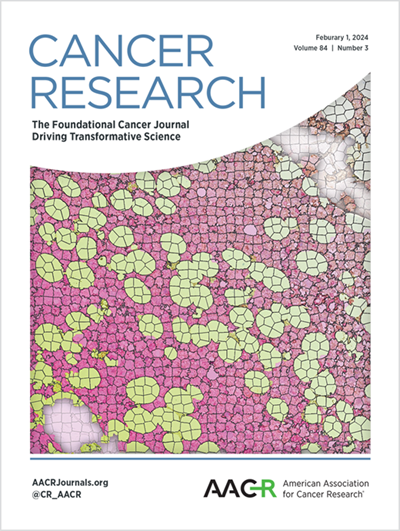乳腺癌扩散的肿瘤细胞:它们是留下来战斗还是逃跑躲藏?
IF 12.5
1区 医学
Q1 ONCOLOGY
引用次数: 0
摘要
包括乳腺癌在内的许多实体瘤都会出现早期扩散和休眠--即癌细胞在疾病过程的早期扩散,并在没有检测到生长的情况下存活很长时间。这些早期扩散的肿瘤细胞有时会重新活化,并在原发肿瘤接受治愈性治疗数年甚至数十年后导致无法治愈的转移性疾病。我们刚刚开始了解免疫系统在这一过程中的作用,部分原因是免疫能力模型的改进以及单细胞基因组学和空间转录组学等技术的进步。在本期《癌症研究》(Cancer Research)杂志上,Bushnell及其同事发现NK细胞在这一过程中非常重要。作者发现,扩散的肿瘤细胞和静止细胞表达较高水平的 MHC 1,但对 NK 细胞介导的免疫具有抵抗力。所提出的机制涉及 STING 通路以及转录因子 Sox2 和 Bach1。由于其他研究强调了 T 细胞免疫的重要性,这项工作再次证实了休眠免疫调节的重要性和多样性,并表明今后的研究需要充实机制细节,并预测每种类型的免疫何时最重要。参见 Bushnell 等人的相关文章,第 3337 页。本文章由计算机程序翻译,如有差异,请以英文原文为准。
Breast Cancer Disseminated Tumor Cells: Do They Stay and Fight or Run and Hide?
Many solid tumors including breast cancer can exhibit early dissemination and dormancy-in which cancer cells spread early in the disease process and survive long periods without detectable growth. These early disseminated tumor cells sometimes reactivate and lead to incurable metastatic disease years or even decades after curative-intent therapy for the primary tumor. We are just beginning to understand the role of the immune system in this process in part because of improvements in immunocompetent models as well as technological advances such as single-cell genomics and spatial transcriptomics. In this issue of Cancer Research, Bushnell and colleagues showed that NK cells are important in this context. The authors found that disseminated tumor cells and quiescent cells express higher levels of MHC 1 but are resistant to NK-cell-mediated immunity. The proposed mechanism involves the STING pathway and transcription factors Sox2 and Bach1. As other studies have highlighted the importance of T-cell immunity, this work reaffirms the importance and diversity of immune regulation of dormancy and suggests the need for future studies to flesh out mechanistic details and predict when each type of immunity is most important. See related article by Bushnell et al., p. 3337.
求助全文
通过发布文献求助,成功后即可免费获取论文全文。
去求助
来源期刊

Cancer research
医学-肿瘤学
CiteScore
16.10
自引率
0.90%
发文量
7677
审稿时长
2.5 months
期刊介绍:
Cancer Research, published by the American Association for Cancer Research (AACR), is a journal that focuses on impactful original studies, reviews, and opinion pieces relevant to the broad cancer research community. Manuscripts that present conceptual or technological advances leading to insights into cancer biology are particularly sought after. The journal also places emphasis on convergence science, which involves bridging multiple distinct areas of cancer research.
With primary subsections including Cancer Biology, Cancer Immunology, Cancer Metabolism and Molecular Mechanisms, Translational Cancer Biology, Cancer Landscapes, and Convergence Science, Cancer Research has a comprehensive scope. It is published twice a month and has one volume per year, with a print ISSN of 0008-5472 and an online ISSN of 1538-7445.
Cancer Research is abstracted and/or indexed in various databases and platforms, including BIOSIS Previews (R) Database, MEDLINE, Current Contents/Life Sciences, Current Contents/Clinical Medicine, Science Citation Index, Scopus, and Web of Science.
 求助内容:
求助内容: 应助结果提醒方式:
应助结果提醒方式:


